Helpful tips
Useful tips when creating Hygienic Environments, meeting or exceeding EU Regulations. Using Modern Methods & Materials.
Wall Coverings
There is a wide range of hygienic wall panels available, generally manufactured from FRP or solid PVC. The selection of a particular type of panel will depend on a number of factors, including the service life, warranty and fire rating required, the nature of the environment, the substrate, and the installation time available. It is preferable to use panels that are Food Taint Test Approved and are resistant to stains, chemicals, abrasion and fire. Where conditions allow, always install panels to a minimum height of 3 metres. Polypropylene sheets are also available but they exhibit a poor fire rating. Foam PVC sheets (as opposed to solid PVC) normally have a softer surface that is more susceptible to damage. Steel Faced Insulation Panels are also available.
Corners
Internal corners finishing wall to wall and wall to ceiling should have a coving with a minimum radius of 50mm for ease of cleaning. Flexible edges or silicone seal jointing should be used, depending on the application. External corners should be finished either with PVC angles or PVC ‘F’ shaped corner extrusions. PVC walls panels may also be thermoformed on site, using an electric heat-forming machine.
Floor to wall finish
A wide range of flooring options is available. Some flooring has pre-formed coving therefore there are a number of jointing methods including the use of extruded PVC capping strips, division bars, birds beak, silicones etc. Always ask for technical information and drawings when considering jointing methods. When pre-formed floor coving is not installed a hidden fix PVC skirting with flexible seals may be used.
Panel joints
Panels can be joined with extruded PVC ‘H’ type division bars with flexible seal edges or rigid edges (for silicone sealing). Always use division bars with expansion gap guidelines to ensure any expansion of thermoplastic sheets is allowed for.
Silicone sealing
Ensure all joints/gaps are sealed with a high quality silicone. The low modulus silicone should have a good long term adhesion and be tested to comply with FDA standards and contain a food approved anti-fungal agent. Silicone should also have a broad operating temperature range.
Adhesives for panel fitting
Use full coverage adhesive to avoid gaps behind the sheet. Ensure that the adhesive is suitable for the substrate. The adhesive should be odourless and be naturally anti-fungal. On slightly damp surfaces, the adhesive chosen should have a ‘damp-tolerance’. Any adhesive used should also be fast curing and have a broad operating temperature range. Hygienic nylon drive rivets should be considered for use in conjunction with adhesive in damp areas. Full coverage, pre-applied, double-sided tape offers and alternative method of fixing to certain substrates.
Ceilings
A range of PVC and FRP hygienic ceiling panels and tiles are available to suit suspended ceiling grids or to fix directly to various substrates. Always ensure that the panel/grid edges are sealed with a food grade silicone. In areas of high corrosion FRP ceiling grids will provide a long service life. Ensure PVC hidden-fix tongue and groove ceiling planks have a good moisture proof joint and are calcium colour stabilised. A 50mm radius PVC coving should be used for wall to ceiling finishing.
Substrate
All surfaces should be flat, dry, clean and free from dust or grease. When necessary, degrease with MEK, alcohol or ethanol. If necessary, use a primer to seal the substrate surface. It is recommended that adhesion tests are carried out to determine the suitability of the product for its application.
Installation
When possible use manufacturer approved installers who specialise and are experienced in fitting Hygienic Walls & Ceiling systems.
General Advice
If regular steam/pressure washing is to be used, seal any flexible joint skirting and coving with adhesive or silicone. This will prevent the pressure washing from lifting the flexible edges. Use calcium colour stabilised product to avoid discolouration, particularly in areas with sulphur, and certain other gases, in the atmosphere. Coloured covings, skirtings and bump rails can be used to differentiate areas for risk definition. When using PVC covings and skirtings choose products with a full range of injection moulded corners and end pieces. This ensure a neat and hygienic finish.
Specify products that are fire rated to Class 1 as per BS Part 7 and, where possible to Class 0 as per BS 476 Part 6.
Look for products that exhibit low smoke development in the case of fire.
Some wall and ceiling panels are available in pastel colours. These may be chosen to create a more aesthetically appealing working environment, without compromising hygiene.
Where possible, choose a complete system from one supplier, to ensure full product warranty. Also ask for copies of fire and other certificates for your records.
Always check Local Building, Fire and Hygiene Regulations prior to ordering and installation.

 NBS Specification
NBS Specification Book a CPD
Book a CPD